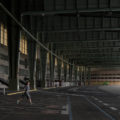“WE ARE NOT YOUR DEMOISELLES”, CANDICE BREITZ
A long, narrow corridor opens before my eyes. Scattered sounds emerge: singing, talking? Nothing recognizable so far. My eyes are attracted by a screen with lips jumping out of it. These lips move, they seem to call me. Invite me. A glass wall separates us, but a connection is already made. Even before the decision to visit this place is made, the works appear from the outside, reminiscent of shop windows designed to attract the consumer.
At this invitation I enter inside the gallery. The sounds, that can be heard outside, are more pronounced here, but they don’t come from the installation that is open to my gaze. The lips move, but they remain silent in my presence. Paradoxically, without a face, these lips are not identifiable and establish an intimate relationship. The proximity of lips remains an area of intimacy between people. Observing a person’s lips so closely is not insignificant. It almost creates discomfort: too much intimacy, an aggression on the sphere of intimacy created by the close-up of her purple lips. Despite this discomfort, they cast a spell over me and force me to stay. Arouse my curiosity. Then I break the silence between us. Words are brutally connected to her lips. Faceless as they are, these lips seem to address me directly. Candice Breitz manages to establish a very close relationship between this clear voice and me. Even if the words are addressed to everyone, the process of approaching the discourse creates a closer relationship between the visitor and the works. First a visual invitation through the continuous movement of these lips in close-up, then the need to take a single headset to hear the voice. No other sound disturbs the visitor. There is only the visitor and these lips. The video installation is reserved for one user, hence the impression of intimacy.

William Nelson Copley, Kiss Me (1965), 99 x 81 cm, Oil on canvas, ©Museum Frieder Burda
After leaving this monologue behind, my steps lead me to a long and narrow corridor. Sudden break. Here I see modern paintings. The theme of these paintings: female prostitution and the underlying theme of women as pleasure objects. Kiss Me(1965) depicts a woman from behind whose corset and lowered panties accentuate her buttocks. No transition between these two spaces. Two different forms of representation, works and probably artists. But nothing prepares me for it.
At first sight, this curator’s association doesn’t talk to me. How do the paintings with scenes of men with prostitutes relate to the previous video installation? The title of the exhibition certainly gives meaning to the presence of the works of two different artists: Candice Breitz: Sex Work in Dialogue with William N. Copley. But beyond the title, it doesn’t seem obvious to me how the curator wants to establish a connection or a dialogue between these two carriers, periods, and subjects. Each room is dedicated to one of the artists. The paintings by William N. Copley are concentrated in this corridor, while the three video installations by Candice Breitz each have their own space. The exhibition seems to concentrate more on two artists in an independent way. Is it because of the limited space – the narrow space that does not allow several people to gather in one place to listen to Breitz’s videos and see Copley’s paintings in the same room? Or is it really the curator’s decision to separate the two?
To begin the exhibition with a first work by Breitz and then suddenly see himself in disarray with Copley’s works. Did I come to see an exhibition only about Breitz?

Candice Breitz, TLDR (2017), 13-Channel Installation. © Kow, Berlin. Photo: Sydelle Willow Smith.
A voice that almost disturbs my contemplation of Copley’s works rises in the background. No pictures this time. Between the paintings, a curtain gives access to a dark room illuminated by three screens from which a young voice sounds. This voice attracts my attention when it speaks loudly but clearly; hard but just; powerful but touching. A child exposes and defends the cause and work of these women. Surprising, but attractive. The fact that a child speaks for these women to defend their work and claim rights. On both sides there are about ten of these workers, who express themselves through words on signs. Does the artist use the child’s voice because it is the voice of innocence in relation to the image of these women’s work in society? Does she point out that the recording of this speech would be different if they spoke directly?
Through her video works, Breitz exposes the fact that society denounces this work and speaks to act on behalf of these women. Here she gives these women a voice through these three video installations. These women are really present here, and as Breitz emphasizes in one of her videos, it is not personalities like film actresses – Kate Winslet or Charlize Theron – who speak in her name, but themselves. The third room shows various videos in which sex workers speak freely about their lifestyles and work in front of the camera. These intimate videos belong to the video installation of the previous room: these two installations are part of the same work. They work together.
Another look is then taken at Copley’s work. The voice of this child seems to give a voice to the women in his pictures. Women’s objects, frozen, intended for the pleasure of the other. Reduced to one function. They wake up, stand up and talk. The second piece, which presents various interviews with sex workers, reinforces this impression. Sex workers are no longer just objects of pleasure, but pure people who defend their work.

Candice Breitz, TLDR (2017), 13-Channel Installation. ©Kow, Berlin. Photo: Sydelle Willow Smith.
Is the installation of Breitz’ works a decision of the artist or the curator? Her three installations show: Lips and faceless words, bodies and writings with the voice of another, individualized person expressing themselves alone. The visitor goes through a process to reach the clear and unambiguous voice of the workers. The artist seems to prepare him to hear the women’s speech, her own words. The curator seems to reverse the situation. Copley’s works no longer speak. They illustrate the work of these women. Another contrast: the exhibition is no longer dominated by a male artist, but by a female artist. The voice of the exhibition is that of the women. Her interpretation is that of the visitor, because the curator gives him the freedom to immerse himself in the works without directing his gaze – the presentation texts are only found at the end of the exhibition.
CANDICE BREITZ: SEX WORK in Dialog with works by William N. Copley from the Frieder Burda Collection.
Museum Frieder Burda, Salon Berlin
Auguststraße 11 - 13
10117 Berlin
21st September 2018 – 5th January 2019
Artist's website: http://www.candicebreitz.net/
Viewing TLDR online: https://vimeo.com/273615691






